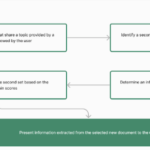You can maximize the content on Google’s SERPs by using the “people also searched for” (PASF).
This feature allows users to see similar queries to their own. It’s almost like having a blueprint of what people are looking for.
This article explains how to use PASF as a tool for SEO or search engine optimization.
Difference between “People also ask” and “People also search for”
The People Also Ask box (PAA), below the original search query, shows a list related queries. They are the questions Google believes your audience will ask when they do their first search.
In the SERP, the box “People Also Ask” is displayed after the first result. This is an example using both PAA and PASF for the query: “What is SEO?” “:
The “People Also Search For ” section contains topics related to the search term, while the “People Also Ask ” section provides questions that are associated with your original search.
Another example of the same question: “What is SEO?” You can see the PASF displayed alongside each PAA when you click on it.
Google’s PAA box could appear after any search. The People Also Search For boxes can appear when a user quickly closes or leaves a tab after typing in a search query.
Difference between ‘Related searches’ and a ‘People also search for’
Similar Searches is a list of questions that users often enter in the search box after narrowing down their search.
These are the eight terms that you find at the bottom of Google SERPs and they are related to the subject of your search.
PASF, on the other hand appears in the search results. It offers users additional queries that are related to their original search query. This is something they often do after visiting a page.
Integrating “People also search for” into your SEO content strategy
1. Find Related Keywords
Google’s goal was to make it easier to find information. By showing users a list related queries, PASF can help them better understand a topic.
The People Also Search is a great way to find long-tail keywords for your website and content.
We can take advantage of the fact that PASF is a topic and question that are connected to the original search query. By creating content that follows the search journey and helps people find what they need.
2. Understanding Search Intent
By matching your content with the search intent of the user, you can ensure that your content is directly relevant to what the user wants.
Examples of the five different types of search intent:
- Informational search intention: When people are looking for general information about a subject, such as specific answers or questions. Examples: “How do you bake a cake,” What is content marketing,” and “Benefits from exercise.”
- Users use navigational search to find a website or webpage. “Facebook login”, “YouTube home page” are examples.
- Users will use this type of search when they are looking to complete an action, such as a purchase or a transaction. Examples: “Order pizza” and “Buy iPhone 13 Online.”
- Users who are searching for commercial products or services do so with the intention of making a purchase decision soon. Comparing options and looking for reviews. Examples: “Best Office Chairs 2023”, “Top-rated Prom Dresses” and “Compare the MacBook Pro with HP Elite.”
- Local search intent: Users search for information, products or services that are geographically relevant. Examples: “Hotels nearby,” “Auto Repair Shops in Chicago,” and “Dentist Office Hours in Miami.”
Google’s main objective is to provide the best possible answer for the searcher. Understanding the intent of the searcher is crucial in answering the questions that the search raises.
Using PASF, you can create content to meet the user’s specific intent. This will allow you to guide users through their journey, increasing conversions.
3. Keyword Research Using PASF Words
The PASF box includes secondary keywords that are closely related to the primary query. This allows you to discover keywords that people are actively looking for.
How to perform keyword research using PASF words for your SEO content strategy.
- Keyword insights By typing in the search term and noting the phrases, topics, and keywords that appear.
- Don’t ignore long-tail keyword : Long-tail words are more specific, have lower search volumes but can result in higher conversion rates.
- Analysis of competitors : Examine how the website ranks for the search terms you’ve chosen, the format in which the content is presented and come up with ideas to improve the content.
- Use keyword research software: Place the PASF keywords that you have discovered in keyword research programs like Google Keyword Planner Tool. You can then analyze and discover more keywords that are relevant to the search intention.
The ‘People Also Search For” suggestions provide a window into your audience’s minds. It is important to use them to better serve your audience.
4. Explore Content Ideas
You don’t have to create every piece of content from scratch. Instead, you can explore a variety of ideas throughout your editorial calendar based on what you learn from the PASF section.
PASF saves time by automatically loading more topics related to your search query. You can get instant information on any topic.
You can generate your own content ideas and topics by searching and jotting down what you find. These PASF questions will help you determine what content needs to be added, updated or modified in your SEO strategy.
5. Refine on-page SEO
Keyword usage is one of the best on-page strategies.
PASF will help you to develop keywords so that you can include them in your content naturally.
Here are some places in your article where you should add PASF keywords to improve on-page SEO.
- Title
- Meta description
- Search engine friendly URL
- Your article should contain the first 50-150 words.
- Image & Alt Text
- H1, H2, H3, and H4 headings
Use jump links and semantic search terms in your content to help your visitors find the answers they are looking for quickly.
6. Optimise Your Existing Content
The internet is constantly evolving. A trending article of a year ago may not be relevant anymore. To generate additional traffic, it is important to update and, if you can, distribute such content in different formats.
You can refresh old content by using the People Also Search tool. Here’s how:
- Increase content depth: The PASF will give you more questions that your audience may ask about a topic. You can answer these questions by adding keywords and phrases to your articles.
- Interlinking within your site: You can encourage users to read more by interlinking articles that are related. This will reduce bounce rates and position you as an expert on the topic.
PASF can be used to keep your information current and interesting. It will not only encourage your readers to engage more but also improve your SEO efforts.
7. Get a competitive edge
The PAS box was created to help people find answers to questions that they may not have thought of asking. If you answer all the questions that a reader might have, you are more likely to be ranked for the PAS Box. Users are also less likely to visit another page if you’ve answered their queries.
PASF allows you to also see what your competitors are lacking. This information can be used to develop content that fills in the gaps, and is more comprehensive than what your competitors are offering. You will increase your click-through rate, solidify your brand’s authority and offer readers a seamless experience.
8. Create Impressive Outlines to Enhance Drafts
Use the PASF insights to create structured content outlines that your writers can follow. Once you’ve chosen a keyword and understood the search intent, it will be much easier to create a content framework that is clear and organized.
These keywords can be included in the brief for content. This will give writers more direction and reduce the likelihood that they will deviate from your specifications. By creating explicit content outlines, you can ensure that the message is consistent with your brand’s goals and objectives.
9. Increase the Top of the Funnel marketing Reach
You can use the PASF questions to generate ideas at any stage of your content creation process. This will help you to provide relevant and meaningful responses to your readers.
People who are looking for answers to People Also Search For questions are typically in an early stage or awareness of their customer journey. You can use the PASF questions as a way to attract leads at the top of the funnel.
PASF: Maximize its PASF feature
Do not underestimate the power and usefulness of “People Also Search For”. This feature gives you valuable insight into your audience’s queries and interests, which allows you to improve your content strategy. This feature can help you stay ahead of your competition, provide better results for your readers, and establish brand authority.



















